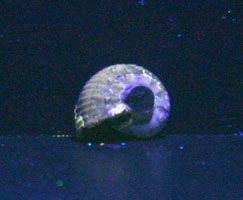Ammonites are an extinct order of carnivorous mollusks that were closely related to the squid, octopus, cuttlefish, and the chambered nautilus. Ammonites mysteriously became extinct at the same time as the dinosaurs some 65 million years ago. The term "ammonite" means "Ammon's Stone." The name was given to these coiled fossils by the Egyptians who noted their resemblance to the horns of their ram headed god, Ammon. Ammonites flourished in oceans for approximately 330 million years.
Ammonites are easily recognized by their beautiful geometrically coiled shells. These shells were secreted by the animal and continued to grow and provide protection for the creature throughout its life. The animal itself probably very closely resembled a modern day squid living in the end of the shell (similar to the chambered nautilus). An ammonite could control its buoyancy much like a submarine, filling its chambers in the shell with either gas or fluid. Ammonites became so prolific that they filled nearly every niche in the ocean.
Many of the ammonites from South Dakota will fluoresce due to the replacement of the shell by calcite and chalcedony. The calcite will fluoresce from white to yellow to orange. The chalcedony usually shows up as a green fluorescence. Usually the stronger fluorescence is under long wave and is the first photo shown in the fluorescents (South Dakota) section of the web site. Chalcedony usually does not fluoresce well under long wave, but does fairly well for the fossils from this area.
The first photo of this specimen was taken under long wave fluorescent light. The replacement mineral here is calcite, as evidenced by the yellow fluorescence. Also check out other South Dakota fluorescent offerings under the Fluorescents section. Then click on the "To view specimen material from South Dakota" link. Some other normal light photos will be shown there as well.
Menuites portlocki complexus (menu=small,detailed + ites=a stone) is characterized by moderate involute (tight) coiling, broad, rounded sides, well rounded venter (outside edge), and deep rounded umbilical walls (center of coil). Microconchs (juveniles) have prominent ribs with tubercles (bumps). Macroconchs (adults) lack ornamentation and have nearly smooth sides. It lived during the Middle Campanian Stage of the Upper Cretaceous (about 78-77 MYA).
The second photo (below) was taken under short wave light. There is a yellow fluorescence the same as with the long wave, just a little less strong. This specimen is also available in the fossil ammonite section. It will have the same item number followed by an "N."
Menuites portlocki complexus 
Quantity in Basket: None
Code: SDA-116
Price: $15.00
Shipping Weight: 0.06 pounds
Time: Upper Cretaceous, Middle Campanian Stage, approximately 78-77 million years ago.
Location: Pierre Shale, South Dakota, USA
Dimensions: 9/16" x 9/16" x 1/2"